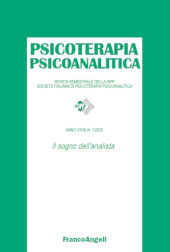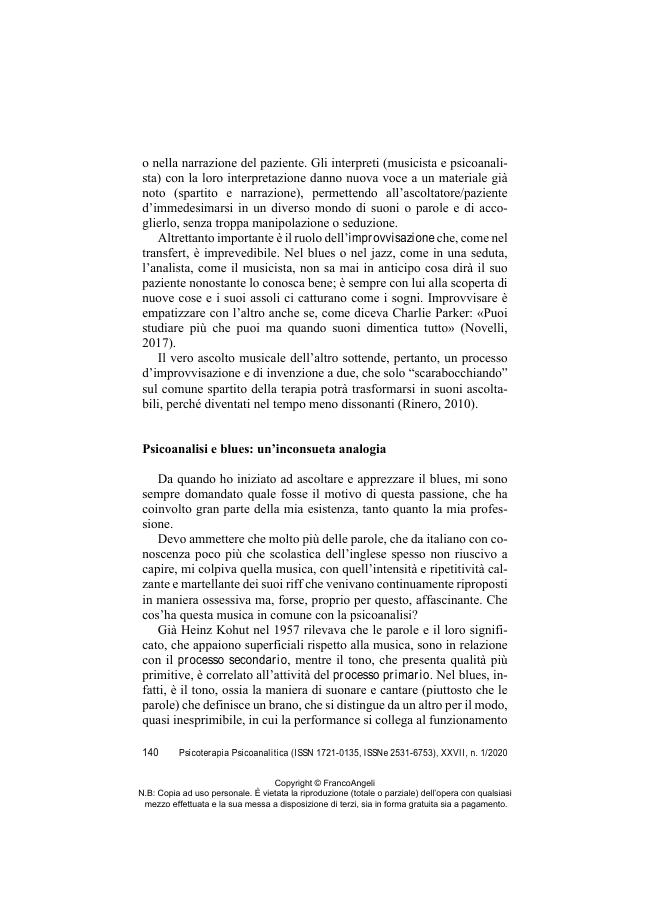La psicoanalisi e il blues : una strana coppia a confronto
130-150 p.
Dopo aver descritto l'origine del blues e i motivi della sua nascita, sono esposte le analogie fra i modi di ascolto in psicoanalisi e nella musica. Sono presi in considerazione i primi lavori di Reik e Fliess per poi passare a quelli di Schafer, terminando con alcuni concetti psicoanalitici comuni alla comunicazione non verbale. Seguono alcune considerazioni sull'argomento prima di porre l'accento sull'analogia fra la funzione fondamentale della musica e della psicoanalisi, che si basa sull'interpretazione e l'improvvisazione. Secondo Kohut la musica, per il suo modo di comunicazione più primitivo, è collegata al processo primario mentre le parole, che sono più superficiali, sono connesse al processo secondario.
Quando ascoltiamo un brano di blues, come in psicoanalisi, si creano, infatti, i presupposti per favorire lo sviluppo di un pensiero onirico della veglia che, attraverso una reverie acustica, riporta alla luce il trauma della sofferenza degli schiavi, che si riflette nelle esperienze personali del terapeuta e nelle sue passioni e fa assumere al sogno, come sosteneva Ferenczi, una valenza "traumatofilica", rendendo me-no traumatiche le esperienze del passato. L'ascolto di un brano di blues ci rimanda alla "Teoria dell'Illusione Estetica" di Kris, che protegge gli individui dalle loro paure reali favorendo, come nel blues, la nascita di sentimenti che in altre condizioni esiteremmo a permetterci.
Prima di terminare con due vignette cliniche, esplicative di come imparare a suonare un buon blues o andare fuori tempo, è descritto il ruolo del setting in psicoanalisi che è simile alle sue dodici battute, che si ripetono in maniera precisa e monotona permettendo che al suo in-terno si sviluppi una narrativa (libere associazioni), improvvisata con le cinque scale pentatoniche. [Testo dell'editore].
After explaining the birth of the Blues and the reasons for it, there follows a description of the analogies between the forms of listening in psychoanalysis and music. The first works by Reik and Fliess are taken into consideration, then those by Schafer, with a brief overview of some psychoanalytic concepts about nonverbal communication. The core functions of music and psychoanalysis seem to be very much the same, in that both music and psychoanalysis rely on interpre-tation and improvisation. Kohut associated music with the primary process, because of its more primitive way of communicating, while words, that are more su-perficial, are associated with the secondary process. As is the case in psychoanalysis, when we listen to a Blues song, preliminary assumptions are created to favour the development of day-time oneiric thinking: thanks to acoustic reverie, the Blues unveils the trauma of slaves' sufferings, which is reflected by the analyst's per-sonal experiences and passions.
Dreaming then acquires a "traumato-philic" value, thus making past experiences less traumatic. Listening to a Blues song reminds us of Kris' "theory of aesthetic il-lusion" which protects individuals from their real fears while favouring â as in the Blues â the development of feelings that we would not dare to get in touch with otherwise. Two clinical vignettes explain how to learn to play the Blues and what it means to play out of time. A comparison is made between the psychoanalytic setting and the twelve bar blues format, a pattern repeating itself in a precise and monotonous way so as to allow the production of a musical narrative (free associations) played on the five pentatonic scales. [Publisher's text].
Ist Teil von
Psicoterapia psicoanalitica : 1, 2020-
Artikel aus derselben Ausgabe (einzeln erhältlich)
-
Informationen
ISSN: 2531-6753
THEMENBEREICHE
KEYWORDS
- Blues, ascolto, controtransfert, illusione estetica, relazione terapeutica
- The Blues, hearing, countertransference, aesthetic illusion, therapeutic relationship



